There When You Need Them
Student EMTs assist in campus and local emergencies; learn valuable lessons through Emergency Medical Services
Posted in: Homepage News, University
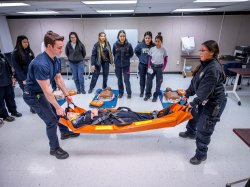
When Angell Alvarez works the night shift as a lieutenant Emergency Medical Technician (EMT) for Montclair State University’s Emergency Medical Services (EMS) program, she sleeps in her uniform so she’s ready for emergency calls.
That way, when she gets a call during the night, sometimes three or four of them, she can quickly jump out of bed, grab her equipment and rush to the scene in the ambulance parked right outside of the EMS base.
As a senior majoring in Molecular Biology, Alvarez joined the EMS program, to receive hands-on patient-care experience and provide comfort to people who need assistance no matter the time of day.
“I really love my job since we’re getting called to someone who’s possibly having the worst day of their life and I’m going to offer that person comfort and make their day a little better,” Alvarez says. “Overnights are more hectic because if somebody’s calling you at three in the morning, they probably need to go to the hospital. So while we are allowed to sleep, those are the calls we really have to be on go for.”
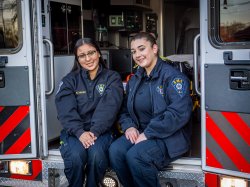
EMT volunteers receive nearly 400 calls throughout the academic year including standby calls at sports games, campus festivities and Commencement. They also experience a handful of off-campus calls to support the surrounding community such as Little Falls, Montclair and Clifton’s Boys and Girls Club.
Michelle Kight, the EMS program manager, says that the program is helpful not only to the campus and nearby communities but is beneficial to the student volunteers as well.
“EMS provides our students an opportunity to gain invaluable, real-life experience and a broad skill set which can be applied to any field,” says Kight. “EMS essentially forces a person to learn how to solve problems, think on one’s feet, and make split-second decisions in moments that are often chaotic. I am grateful for the opportunity to work with these outstanding students as they develop their skills and professionalism.”
Liliana Esmail, a senior majoring in Biology, is also a lieutenant EMT who works alongside Alvarez. She describes her shifts as being unpredictable.
“Your shifts really can be unpredictable because you could go a day where you have nothing or you could go a day where every hour you clear from one call you get sent to the next but it’s also the fun part of the job.”
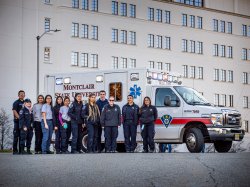
The busiest time for calls is during their weekly daytime shifts when they get a variety of calls from sprained ankles and minor cuts to psychiatric calls when patients experience panic and anxiety attacks. Alvarez says that her most memorable experiences with EMS have been working with psychiatric patients because she is able to exercise her communication skills.
“It’s not like you can give them a Band-Aid and they’ll feel better, it’s more about talking to the patient so they don’t feel alone,” Alvarez says. “It makes my communication a lot better with patients and my communication with partners better and overall skills like that are lifesaving.”
Each member of the EMS program must work 12 hours each week, split into four-hour blocks that fit into their class schedules. The program is always seeking new members and offers a variety of jobs in which volunteers can learn and grow.
Some of the positions include becoming a CPR member with the chance to be sent to EMT school free of charge. Once a student becomes an EMT, they are then qualified to become a resident EMT and cover night shifts and weekends. Students can also become field training officers, which entails creating the curriculum other students must complete to move on to EMT school and organizing training nights for incoming members. Then the final level and position in the program is becoming a lieutenant like Esmail and Alvarez. Rounding out the officer ranks are lieutenant Katie Reidmiller, a senior Physical Education major, Field Training Officer (FTO) Zackary Epright, a junior Chemistry major, and FTO David Pandoscak, a senior Information Technology major.
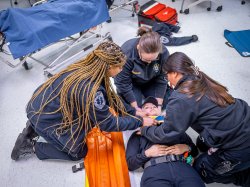
“It is so rewarding to just be able to start from the bottom and move up since it’s great leadership experience and we deal with so many different levels of people since we go hand in hand with first responders like our campus police, and also deal with administrators like Dr. Soufleris, and I just feel like this squad has helped me become a better leader and an educator and it’s all just really rewarding,” says Esmail, who has worked her way up the ladder in the last three years.
When the EMT members aren’t working, they are either studying or in classes. Esmail says it’s important to wear the uniform only during shifts and never to class or while walking around campus. The radio must always be turned off during non-working hours so it does not cause others to panic if they overhear emergency calls.
“I don’t like to walk around in uniform if I’m not on shift because you never know what you can walk into. An EMT has equipment during shifts like an ambulance and a stretcher but God forbid something happens in front of me and I am not on shift, I won’t have those resources in my pocket other than to call 911,” says Esmail.
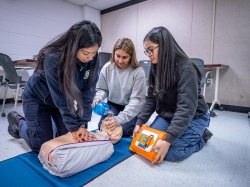
The EMS program provides its volunteers with learning experiences in the medical profession, as well as unforgettable experiences helping people.
“Coming in, I was a very shy person but being in this department made me grow not only as an EMT but also as a person,” says Alvarez. “What’s memorable for me is how we take care of random people, and it’s not like we’re going to see them again but one time I was walking in the Student Center and one of my patients recognized me, thanked me, then told me what happened after I took them to the hospital even though we don’t usually follow up so I think that’s rewarding because it’s just that while I remember my patients, they seem to remember me too.”
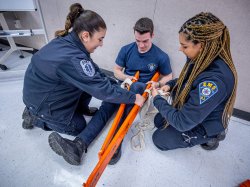
“This program lets me carry my characteristics of speaking to people, being a leader and an educator which is something this squad really let me do,” says Esmail. “I got a lot of advice from higher-ups that taught me how my teaching and leadership style differs from other people’s, which is interesting to learn about and helps me improve in my experience.”
For more information or to join the EMS program, visit the EMS website.
Story by Rosaria LoPresti. Photos by University Photographer Mike Peters.
